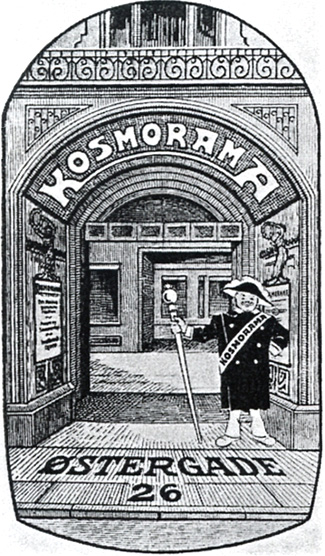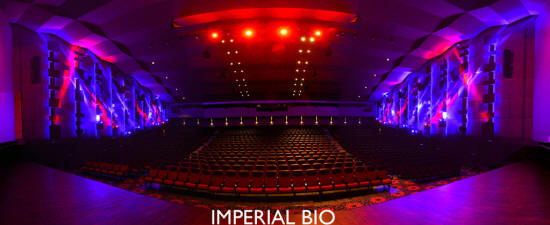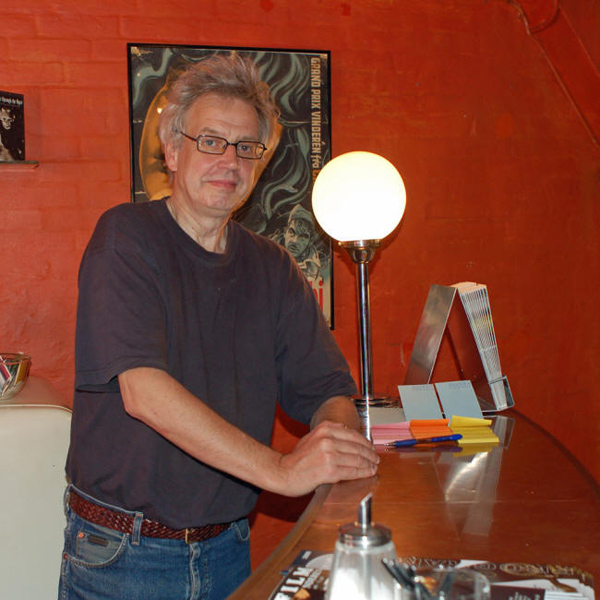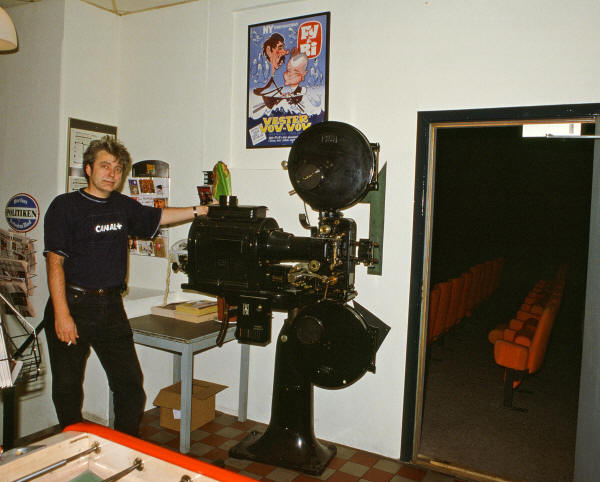Cinemas of Copenhagen |
Read more
at in70mm.com The 70mm Newsletter |
||||||||||||||||||||||||||||||||||||||||
| Written and photographed by: Thomas Hauerslev. This article was first published in Cinema Technology, March 2001. Reprinted with permission from Jim Slater. | Date: March 2001 | ||||||||||||||||||||||||||||||||||||||||
|
|
More in 70mm reading: 70mm Cinemas and Film in Denmark PDF: Cinemas of Copenhagen Update of Cinemas of Copenhagen - An in depth look at all the screens Three Great Danish 70mm Cinemas Internet link: |
||||||||||||||||||||||||||||||||||||||||
Introduction |
|||||||||||||||||||||||||||||||||||||||||
 Cinema Technology, March 2001 Cinema Technology, March 2001As of January 1st 2001, there were 11037 seats, 58 screens at 13 cinemas (5 single screens) located within a radius of 1 km (0,625 miles) from the Central Station. Most of the cinemas are multiplex screens. CinemaxX (10 screens), Dagmar (5), Grand Teatret (6), Scala (7), Palads (17) and Palladium (3). This concentration is quite different from 30 years ago when there were no multi screen cinemas. Before 1970 the cinemas were scattered all over Copenhagen. Today only very few are outside the 1 km radius. Those outside are the Bio in Vanløse, Park in Østerbro, the Drive-in open only during summer and from January 5th, the Empire 4-plex at Nørrebro. The major players are: Nordisk Film Biografer A/S with Palads, Palladium and their flag ship Imperial, Sandrew/Metronome with Dagmar and Scala, CinemaxX with Fisketorvet and finally the independent Grand. Ringside players are Gloria, Husets Biograf, Vester Vov Vov and Posthus Teatret (The latter has the only rear-projection system in Denmark. A Bauer U5 is used). Also noteworthy are 3 cinemas at the Film Museum: Asta (Nielsen), Benjamin (Christensen) and Carl (Dreyer), named after 3 Danish film pioneers. The Film Museum relocated and opened these 3 new cinemas in 1997 and shows archive prints every day except Mondays. One disappointing fact and a great shame is that they cannot show 70mm films. Copenhagen also has an IMAX Dome cinema, the Tycho Brahe Planetarium. Since 1989, more than 30 IMAX movies have been shown on the largest screen in Denmark. The cinema has a remarkable JBL sound system and of course IMAX DDP digital sound (Introduced in 1991 with "Rolling Stones At the Max"). The latest novelty is the presentation of "3D Mania" in ColourCode 3D, a Danish invention. On October 6, 2000 the German CinemaxX Group opened their first 10-screen complex in the center of Copenhagen. For the first time, foreign cinema operators are taking a serious bite of the audience in Copenhagen. During the 80s and 90s, foreign investors like Sandrew (Sweden), MGM/Pathé and Warner/Village also invested in existing Copenhagen cinemas. It is clear from the table above that both Grand and Imperial Bio have lost a considerable share of the market since CinemaxX opened in week 40. It will surely be interesting to monitor developments during the following months. |
|||||||||||||||||||||||||||||||||||||||||
|
|||||||||||||||||||||||||||||||||||||||||
|
|||||||||||||||||||||||||||||||||||||||||
The first Century of Cinemas |
|||||||||||||||||||||||||||||||||||||||||
 The first Danish
performance of Lumiere Brother's moving pictures dates back to 1896. The
moving pictures was presented at the Town Hall Sq. in Copenhagen. Another
8 years would pass, however, before the first permanent cinema "Kosmorama"
opened September 17th, 1904 at Østergade 44, now "Strøget",
the pedestrian street. The first Danish
performance of Lumiere Brother's moving pictures dates back to 1896. The
moving pictures was presented at the Town Hall Sq. in Copenhagen. Another
8 years would pass, however, before the first permanent cinema "Kosmorama"
opened September 17th, 1904 at Østergade 44, now "Strøget",
the pedestrian street.The Kosmorama has long since closed. Closure of cinemas is actually very common, however. Since 1904 more than 100 of Copenhagen's cinemas have closed! In fact today, only the Palads, the Dagmar, and the Grand dates back before 1960. What happened to the closed cinemas? Well, most of them have been demolished to make room for new developments (in some cases new cinemas). During the 1970s wave of closures in greater Copenhagen area, at least 16 cinemas were converted into supermarkets, of which many can still be seen. They are: Alladin, Atlantic, Bella Bio, Bispebjerg Bio, Casino, Colosseum, DSB Kino, Fasan, Merry, Nora, Nørreport, Park, Platan, Roxy, Skovshoved Teater & Søborg Teater. Other ex-cinemas still to be seen serving other purposes in greater Copenhagen are: Alexandra (disco), Tivoli Bio (Hard Rock Café), Carlton, Vanløse Biograftheater & Øbro Bio (churches), Bio Lyngby (Furniture store), Husum Bio (Exercise gym "Kondigrafen"), Metropol (Hennes & Mauritz), Kinopalæet (office space and demolished in december 2001), Bellevue, Mercur, Nørrebro's Biografteater, Rialto, 3 Falke Bio and World Cinema (live theatres) and finally Standard Theatret (video shop!). So, nearly 30% of all cinemas are still there, "sleeping" like dinosaurs from an ancient time. The tale of the closed cinemas in Copenhagen must wait to be told another time. |
|||||||||||||||||||||||||||||||||||||||||
The Sound of Copenhagen |
|||||||||||||||||||||||||||||||||||||||||
 Sound on film is
not new to Copenhagen movie lovers. Axel Petersen and Arnold Poulsen are
ranked as film sound pioneers as they invented one of the worlds first
practical sound with film systems 80 years ago. They demonstrated their
system at Palads Teatret October 12, 1923. Sound on film is
not new to Copenhagen movie lovers. Axel Petersen and Arnold Poulsen are
ranked as film sound pioneers as they invented one of the worlds first
practical sound with film systems 80 years ago. They demonstrated their
system at Palads Teatret October 12, 1923. The big issue today is of course what kind of sound system the cinema has. The buzz word is "digital" and most of the premiere houses have Dolby Digital installed (37 screens, 64%). Second in line is DTS (12 screens, 21%) and finally SONY's SDDS (2 screens, 3%). Four screens have installed Dolby Surround EX, but surprisingly, none of the brand new CinemaxX screens have EX. 6 screens (10%) are THX certified. They are: Imperial Bio, Scala #1#2#3, CinemaxX #1 and Palads #1 & #9. In comparison, there are 36 THX certified screens in Denmark. A single screen, Imperial Bio also carries a Kodak Screencheck certification. The successful Dolby Stereo cinema processors have been installed in Copenhagen extensively since the first CP50 processor arrived in Palads Teatret in December 26, 1978 for "Superman". These days the CP500 is installed at 26 screens and the CP650 at 1 screen. There are two CP200s (There has never been a CP100 processor in Denmark), 11 CP65s, one CP45 and several CP50/55s still in action. In fact nearly 83% of all screens have some form of Dolby processor installed. Until the late 1980s, the A and B chains were often outdated low-end equipment from the 70s and the sound quality was mostly rubbish, only just surpassing the quality of analogue telephone lines. I'm exaggerating of course, but sound was really terrible. Most screens lacked fidelity, clarity in the high end, deep powerful thundering bass and stereo perspective. Only the Imperial Bio provided superior sound with a Dolby CP50, JBL speakers and SAE amplifiers. A simple, yet most impressive set up, installed for "Alien" in October 1979. Luckily, it's a different story today. I think the real turning point came when the Scala opened in 1989 with 5 excellent screens built to THX specifications (but not actually THX "certified" at the beginning). Many theatres have since upgraded with new amplifiers and speakers. The typical speaker is either JBL or KCS. Amplifiers are typically QSC or JBL. It still puzzles me, however, why sound quality in these newer cinemas hasn't improved tremendously with all this excellent and costly installed equipment!! An example is the Imperial Bio with THX, JBL and everything. I remember getting frequent goose bumps from the old JBL system, but I never get that from the new system. The system lacks transparency and fidelity. All films now seem to sound the same, and there's nothing beyond 12 kHz anymore!!! It used to be hi-fi sound, but now it's like any other "no-name" THX cinema with PA sound and exaggerated bass. The audience seems to like it, but it should play much, MUCH better with so many speakers and amplifiers. That's sad. |
|||||||||||||||||||||||||||||||||||||||||
The Format is the Thing |
|||||||||||||||||||||||||||||||||||||||||
|
57% of all
screens can show at least 3 standard 35mm formats; anamorphic 2,39:1, flat
1,85:1 and/or flat 1,75:1/1,66:1. Nearly every third screen can show the
Academy format of 1,37:1. Unlike other capitals of the world, the 70mm Dolby format was not used in Copenhagen (no thanks to distributor/exhibitor resistance of importing the more expensive 70mm prints) until the re-release of "Lawrence of Arabia" in 1989. Only 3 cinemas can show 70mm today; Imperial Bio, Palads Teatret screen 9 and 15/70 at the IMAX Dome. The latest dramatic film to be shown in 70mm was "Titanic" in 70mm DTS during 11 record-setting weeks at the 1102 seater Imperial! Other forms of non-standard filmed entertainment has been shown over the years. In 1959 "Windjammer" was shown in CineMiracle. 3-strip Cinerama appeared in 1962 and vanished again in 1963. Cinema 180 was shown in two places in the 70s/80s and Motion Master was shown very briefly in 1991. |
|||||||||||||||||||||||||||||||||||||||||
Equipment Supply |
|||||||||||||||||||||||||||||||||||||||||
 Two major
projector manufacturers have a strong foothold in Copenhagen. For 20
years, both Cinemeccanica (43% market share) and Kinoton (47% market share) have supplied most
of projectors. There are no Century, Westar or Ballantyne projectors in
Copenhagen. There are a number of other uncommon machines running. Three
Bauer U4s, a single Bauer U3, a very rare U5R and a Prevost P55. A pair of
Philips
DP70 are still used at the Imperial
Bio. In fact those pair of machines have been running 10 hours every day
since November 3, 1961, an outstanding achievement. The popular Victoria 5
is used extensively at the Palads and many of them date back to the late
70s when they were first installed. The Victoria 8 is also used in several
cinemas. Two major
projector manufacturers have a strong foothold in Copenhagen. For 20
years, both Cinemeccanica (43% market share) and Kinoton (47% market share) have supplied most
of projectors. There are no Century, Westar or Ballantyne projectors in
Copenhagen. There are a number of other uncommon machines running. Three
Bauer U4s, a single Bauer U3, a very rare U5R and a Prevost P55. A pair of
Philips
DP70 are still used at the Imperial
Bio. In fact those pair of machines have been running 10 hours every day
since November 3, 1961, an outstanding achievement. The popular Victoria 5
is used extensively at the Palads and many of them date back to the late
70s when they were first installed. The Victoria 8 is also used in several
cinemas.The Kinoton FP30 E is used throughout at CinemaxX's 10 screens. The image steadiness on the large screens is outstanding thanks to the electronic "intermittent", done with step motors. The FP30 is also installed at Dagmar, Grand and Scala. Historically there have been many cinema equipment companies in Denmark. Dating back from the turn of century is Dansk Kinematograf [DKF] A/S located in Copenhagen. They specialize in Philips/Kinoton, Dolby, ISCO and JBL equipment. The company is managed by Mr. Jørgen Søndergaard and Mr. Lars Abel. DKF A/S, did not supply projectors, amps or processors to CinemaxX. Kinoton supplied all equipment directly to CinemaxX in Copenhagen, pre-assembled in Germany. In Århus, 2nd largest city in Denmark, another respected company recently (1993) entered the field of cinema equipment. Mr. Asger Bak is managing AB Global A/S and he sells Cinemeccanica, Skeie seats, ISCO lenses, Dolby equipment and installs THX in Denmark. AB Global is responsible for most of Nordisk Films Biografers recent updates and new cinemas. |
|||||||||||||||||||||||||||||||||||||||||
The Ruler of Design |
|||||||||||||||||||||||||||||||||||||||||
|
Danes have a
long history of cinema design. The craft blossomed and developed in the
late 1950s with great cinemas, purposebuilt for CinemaScope and Todd-AO.
Holger Pind, Ole Hagen and Erik Engelstoft are all names of great cinema
designers. Each cinema was different from one another, unlike today when
most cinemas look the same. Today, most of their works have been
destroyed, in the name of progress and competition, especially in the 70s
when many cinemas were either closed/demolished or re-built into a 2-plex,
3-plex or more. The current trend is to build cinemas with "stadium" style seating and a large flat screen in front of you. This environment creates a very effective cinema, especially if the auditorium is kept in dark colors. The down side is, however, that all cinemas are built the same, so there is no real reason to prefer one theatre over another. They all become the same and the "romance" if you will, of cinema-going is gone. It's a shame. The Scala cinemas, opened in 1989, were the first modern style cinemas just described. Before Scala, most Copenhagen cinemas dated back from the 70s with the shoe-box styled cinema, disliked by so many moviegoers. Scala was definitely a move in the right direction, but stadium seating and a wall-to-wall screen had already been introduced with the opening of 3 Falke Bio, in 1958!!! The recently opened CinemaxX pushes the design issue even further by introducing some VERY large screens. The largest even too big in my opinion, since the 35mm image is washed out and contrast and colors are lost. 70mm ought to be used on any screen wider than 17 meters. Which brings the subject to screen size. CinemaxX advertised their screens to be up to 80% larger than ever seen in Copenhagen! It is simply not true, as there are several examples of screens larger than CinemaxX's magnificent screen #1 in Copenhagen. The IMAX Dome screen is nearly 3 times as large and in 1962, 3-strip Cinerama was shown on a screen nearly 28 meters wide! Their claim offended a lot of people and made a lot of controversy. The discussion even hit the newspapers and local TV. In this case our new guests, the Germans, must have consulted with an amateur in Copenhagen screen size history. Here are the facts as I see them. |
|||||||||||||||||||||||||||||||||||||||||
Screen and theatre sizes: |
|||||||||||||||||||||||||||||||||||||||||
|
|||||||||||||||||||||||||||||||||||||||||
Screen and theatre sizes for closed cinemas: |
|||||||||||||||||||||||||||||||||||||||||
|
|||||||||||||||||||||||||||||||||||||||||
|
The largest cinemas in terms of number of seats are Imperial Bio (1102), CinemaxX #1 (754) and Palads Teatret #1 (689). The smallest cinema is screen Benjamin at the Film Museum with a disappointing 42 seats. Almost half of the cinemas of Copenhagen (25 of them) have less than 100 seats. The aforementioned 58 screens contain 11037 seats. The average number of seats is 190. However, if the three largest cinemas are removed (23% of all seats), the average theatre size will be 154 seats, a number which is more accurately reflects reality. |
|||||||||||||||||||||||||||||||||||||||||
Distribution & Programming |
|||||||||||||||||||||||||||||||||||||||||
|
The distribution of films is done by Nordisk Film A/S, United
International Pictures, Buena Vista and Warner/Metronome.
Nordisk Film
handles titles from Columbia, TriStar, MGM. UIP have Paramount and
Universal and recently they added titles from ScanBox Films. All companies
also distribute domestic films. All foreign films are shown in original
versions with Danish subtitles. Animation is dubbed into Danish but often
released in original language versions as well. |
|||||||||||||||||||||||||||||||||||||||||
All Cinemas One by One |
|||||||||||||||||||||||||||||||||||||||||
|
CinemaxX:
The latest addition to the cinemas of Copenhagen. 10 big screens with
state-of-the-art projection- and sound equipment and modern auditoria
appearance of off-the-shelf interior "design" or lack thereof.
On the positive side, the screen in the largest cinema is curved. JBL, QSC
and 2x10mm² wires are used throughout. A most eye-catching waterfront
glass wall, which surely will be used a lot next summer. Free parking
space, and a very spacious and clean restroom. Some very confusing
television screens displaying what is being shown flaw the entrance. Dagmar: 5 screens next to Town Hall Sq. Features digital sound and JBL speakers in all screens. A very informative web site. Movie books and CDs are sold from the box office, a café and a nice red tall neon sign. The staff are always on top of things and making the foyer a nice place to wait for the film. The foyer was "updated" last year to Swedish Sandrew high-tech standards. Dagmar and Scala are managed by Sandrew/Metronome. Filmmuseet "Cinemateket" Technically top-of-the-line screens, a café and a bookshop. Cinemas are named after three Danish film pioneers (not cinema, but film pioneers). The environment around the cinemas is very sterile and perhaps a nice place for the cultural film elite in this country. It is not my cup of tea. The cinemas show a diverse range of old films, but never 70mm. Web: www.dfi.dk and press Cinemateket. Gloria: Very good atmosphere in the tiny foyer. The projectionist, who is also in charge of ticket sales etc, sells video films and French movie posters. I like to request a nice neon sign please. Member of "Europa Cinemas". Grand: One of the oldest cinemas in Copenhagen and still independent. Have specialized in French movies since the 60s although the programming is much more mainstream today. Digital sound is featured in 5 of the 6 screens. The excellent café in the tiny foyer is always crowded before films begin. Posters for sale at reasonable prices. Sadly, they took their neon sign down a few years ago. Put it up again, please. Member of "Europa Cinemas".  No
cinema wiout a manger. Mr Børge Nielsen has managed Huset's Biograf for
many, many years. Image by Thomas Hauerslev, 03.07.2008 No
cinema wiout a manger. Mr Børge Nielsen has managed Huset's Biograf for
many, many years. Image by Thomas Hauerslev, 03.07.2008Husets Biograf: Independent cinema specializes in films not shown anywhere else. Well hidden on the second floor inside an old warehouse. Imperial Bio: State of the art Grandeur in size, picture and sound. Celebrates its 40th anniversary in 2001. Managed by Nordisk Film and home of most red-carpet premieres in Copenhagen. There's a large dedicated crowd of "Imperial Junkies" who see everything there BECAUSE it is Imperial. Probably the best cinema in the world. Only drawback is the pervasive smell of popcorn. Palads Teatret: A Copenhagen landmark cinema dating back to 1918. Rebuilt 1978 and 1979 into 17 screens and became a model for many multiplex cinemas since. Although many screens are small, Palads remains a very popular cinema among the younger moviegoers, probably because Palads is always running a film worth seeing. Like the Imperial and Palladium, Nordisk Film manages Palads (And it a money-maker!). A very interesting café dedicated to the Olsen Gang movie series (1968 - 1999) with lots of memorabilia from 14 films. The building was painted by professor Paul Gernes in 1989 in an incredible symphony of colors. Palladium: Nordisk Film's cinema for the mature audience. Opened in 1978 and renovated twice during the 90s with JBL speakers and new Skeie seats. Located in a mall just off Town Hall Sq, Tivoli and opposite Scala cinema. Lots of posters for coming attractions and a large café. Managed by Nordisk Film. The mens rest room has recently been renovated. Posthus Teatret: Perhaps the most eccentric of all Copenhagen's cinemas. A privately run and owned cinema with rear projection. The cinema is quite small and located in the basement. The manager is also distributing his own films with great succes. Scala: The Scala cinemas are located on the 4th floor in a shopping centre. All screens are state of the art with JBL speakers, THX (#1, #2, #3 only) and digital sound. If the management would address the smelly restrooms, worn out seats, sticky floors and noisy foyer music seeping into the cinemas during commercials, however, the overall experience of Scala would be much better. A BIG plus for Scala is excellent design of cinema's #1, #2, #3 (although a curved screen would enhance #1). Another plus for the location is the out-door café during the hotter summer months and the four immense 24-sheet posters on the exterior facade. Closed, see the update Tycho Brahe Planetarium: Some people will argue that "it's not a cinema". Well TBP shows IMAX Dome films 11 hours every day, 7 days a week, 365 days a year and has done so since opening in 1989. On top of that it's the largest screen in Denmark. The foyer is rather boring and except for a single poster or two, certainly not exposing the IMAX 70mm experience in any way. A large neon sign on the front would not hurt, except the architect's pride I suppose. |
|||||||||||||||||||||||||||||||||||||||||
 Vester
Vov Vov manger and owner Torben Wolsgaard next to an Erneman V on display in
the foyer. Picture by Thomas Hauerslev Vester
Vov Vov manger and owner Torben Wolsgaard next to an Erneman V on display in
the foyer. Picture by Thomas HauerslevVester Vov Vov: The only cinema to take its name from a vintage Danish silent film. Two screens, a splendid café and a pooltable. Member of "Europa Cinemas". The café tables and chairs are made by Maison Drucker S.A. just north of Paris. An old Ernemann V is displayed in the foyer. The specialty of VVV is the airplane seats in screen #1. ...and next door to Copenhagen |
|||||||||||||||||||||||||||||||||||||||||
Summary of Copenhagen's cinemas |
|||||||||||||||||||||||||||||||||||||||||
|
All cinemas are
very close to public transportation, they all show the end titles of films
and most projectionists manage to focus quickly. All projectionists I know
are very skilled and take great pride in their job. Many of them work full
time and spend many hours in the cinema. They are all very open to
visitors who ask permission to see the projection room. The minimum wage
for a projectionist here is DKK 107,75/hour (Nearly 10 British pounds). Most cinemas have a café, where you can buy everything your heart desires; popcorn, chocolate, beer, wine or a drink before the film. Ticket prices range from around DKK 50 to DKK 85 (GBP 4,3 - 7,4). There are still needs for a dramatic increase in rest rooms for women around town. The smell of popcorn can be reduced everywhere without any complaints from me, and more neon signs would be a nice touch. I most enjoy screens which are curved and equipped with curtain but they are rare. It would be fabulous if the digital sound format and cinema in which the films are shown were specifically announced in the advertising. At most of the cinemas you can buy your ticket in advance on a reserved seat basis, even several weeks ahead. By the way, the first row of seats in Danish cinemas is known as #1 and it's always nearest to the screen, except at CinemaxX it's different: the first row I called "V" and the last row is "A". I think we have a very high standard in our cinemas here in Copenhagen both in equipment terms, how films are presented and how the cinemas are kept and run. There is of course room for improvement here and there but things are constantly being updated. Judge for yourself next time around you come for a visit. |
|||||||||||||||||||||||||||||||||||||||||
|
Go: back
- top - back issues
- news index Updated 22-01-25 |
|

